





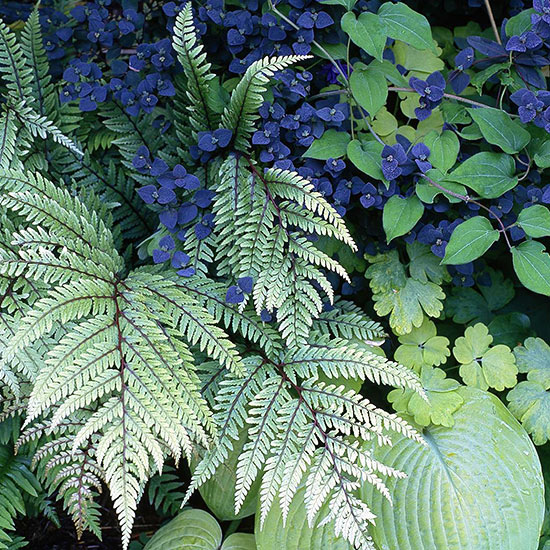 Silver fern, hosta, columbine, andthe blue leaves of euphorbiagleam in this shady vignette.
Silver fern, hosta, columbine, andthe blue leaves of euphorbiagleam in this shady vignette.
Foliage has an essential and complex function in the plant world. It converts sunlight to life-sustaining sugars. In garden design, leaves assume equally important roles. They prolong a border's attractions through the season, giving it depth, flow, and personality. Whereas flash-in-the-pan flowers display vibrant colors timed to guide inbound pollinators, leaves put on a longer-running show.
Leaves build architecture. Used as hedging, ground cover, background, or striking specimen, foliage defines garden contours and skylines.
Related Slide Show: Best Green-Leaf Plants for Your Garden
continue reading below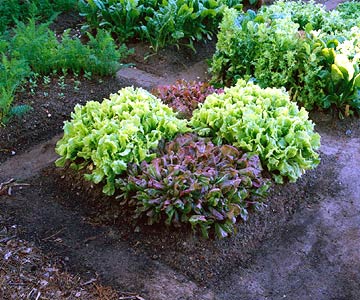 Burgundy and bright green lettucesbring a colorful contrast to avegetable garden.
Burgundy and bright green lettucesbring a colorful contrast to avegetable garden.
In fact, a planting limited to green palettes fascinates as much as a floor show of flamboyant blooms. Of all colors, green is viewed and perceived most easily. Using various shades of green only and interweaving delicate, airy foliage with coarser leaves creates an impressive tapestry that's easy on the eyes. In an all-green garden, a single plant with bold, dramatic foliage assumes the spotlight where flowers would usually stand. It has equal impact.
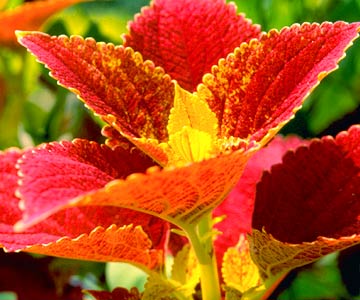 Coleus inflames containers and bedswith a color range from bronze togold to purple and lime green.
Coleus inflames containers and bedswith a color range from bronze togold to purple and lime green.
As if green's foliar offerings weren't riches enough, leaf hues span the entire spectrum. Foliage artists can dabble in shades from the smoky black of mondo grass (Ophiopogon 'Nigrescens') and snake root (Cimicifuga racemosa) to the ghostly silver-white of Artemisia lactiflora and Eryngium. Purple, red, blue, silver, and golden foliage all supply pigments for composing vibrant garden masterpieces. Color-splattered leaves, such as those found in coleus and tovara, match almost any other leaf or flower color. Many plants also have contrasting leaf veins that coordinate with other foliage colors.
Every foliar hue has a special effect in the border. Green calms and soothes, which is why gardens designed mainly with greens offer welcome relief in urban settings and meditational refuges such as Japanese tea gardens. Blue and blue-green foliage, found in fescue and oat grass, create a cool and elegant link to other colors in a garden. Blue leaves mixed with purple-leaf plants and magenta flowers look spectacular.
Related Feature: Purple Passion Container Garden Design
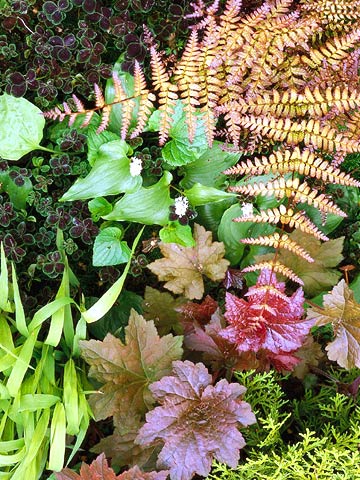 Oxalis, or wood sorrel, oak fern,
and Heuchera 'Palace Purple'
create a subtle symphony of color.
Oxalis, or wood sorrel, oak fern,
and Heuchera 'Palace Purple'
create a subtle symphony of color.
Purple and burgundy foliage anchor garden borders, giving them solidity. The warm reds in coleus, maple trees, and ornamental grasses such as miscanthus raise the pulse of foliar compositions with excitement and drama. Yellows have the same uplifting effect as sunshine in the border.
Gray and silvery gray foliage play magic leaf tricks. Although gray is a neutral mix of other colors, it reflects tints of complementary color partners. Next to red, it becomes slightly green. Paired with violet, it appears yellowed. Grays placed near orange have a blue tinge.
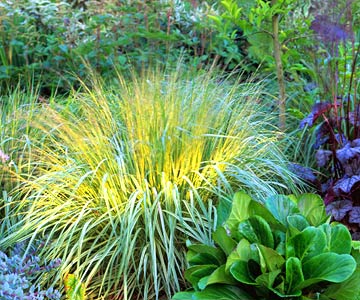 Golden ribbon grass, purple-leafHeuchera, and bergenia createa harmony of contrasting colors,textures, and shapes.
Golden ribbon grass, purple-leafHeuchera, and bergenia createa harmony of contrasting colors,textures, and shapes.
Speckled, striped, or margined, multicolor leaf patterns serve up a little something different on the foliage color menu. Two-tone leaves are bicolored, whereas patterned leaves are variegated. The most common variegations express themselves in cream-, yellow-, or white-and-green foliage. Other, rarer, color patterns include the silver streaks in Heuchera, Tiarella, Pulmonaria, and Lamium leaves, as well as the rainbow splatters found in Japanese maple hybrids, Leucothoe, and other plants.
Vegetable leaves also display wildly variegated colors. Be sure to include red-speckle leaf lettuces, the frosted blue-green and lavender found in ornamental kale and cabbage, plus 'Rainbow' chard in your foliar palette of special effects.
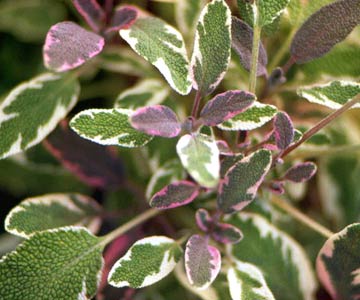 'Tricolor' sage pleases the eyeas well as the taste buds.
'Tricolor' sage pleases the eyeas well as the taste buds.
Overall, variegated plants lighten and refresh a border, especially when blending green and white or green and cream. Plants naturally develop multicolor leaf mutations; then plant breeders discover, preserve, and copy them. Due to the instability in a hybrid's genetic makeup, it takes extra effort to help these plants thrive in the garden and sustain their showy leaves. Adequate fertilizer and plenty of sunlight preserve the showy foliage. Cut off flower stalks of variegated plants, such as polka-dot plant (Hypoestes), coleus, lamb's ears, ornamental cabbage, flowering kale, lettuce, and basil, to ensure leaf vigor and continuous color.
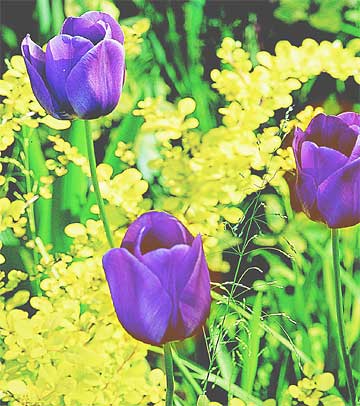 'Bowles Golden' tufted sedge,Anthriscus 'Ravens Wing', 'Aurea'barberry, variegated hosta, and'Negrita' purple tulips provide acolorful range of leaf hues.
'Bowles Golden' tufted sedge,Anthriscus 'Ravens Wing', 'Aurea'barberry, variegated hosta, and'Negrita' purple tulips provide acolorful range of leaf hues.
You might associate yellow flowers with the sunny peak of summer, but golden foliage imparts instant warmth to a landscape year-round. Especially valuable in regions dominated by cloudy skies and diffused light, gold-leaf plants supply the missing sunshine. Shady areas, a frequent challenge in mature landscapes, take on a glow with golden foliage. You have many options when it comes to painting the border gold. The gold-tone leaf has become a focus in recent breeding and gilds everything from ground covers and vines to trees.
Most foliage shows a hint of gold when first emerging in spring. Most tree and shrub foliage turns to burnished gold, prompted by fall frosts. Conifers, including Chamaecyparis, wear winter cloaks of gold-tinged green.
Related Slide Show: Best Yellow Flowers for Your Garden
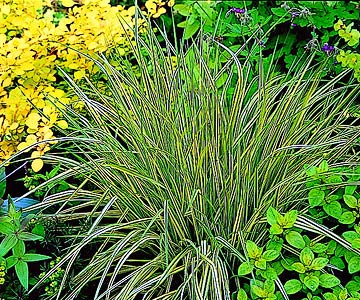 Variegated moor grass and 'Aurea'
barberry star in this golden
garden scene.
Variegated moor grass and 'Aurea'
barberry star in this golden
garden scene.
Other gold nugget plants include the most popular ornamental grasses for shade, Hakonechloa macra 'Aureola' and sedges. Are you bold enough for bamboo? Consider the 'Golden Goddess' and yellow-groove bamboos.
Pale gold and green-and-gold variegated hostas, reportedly more tolerant of sun, include 'Frances Williams' and 'Gold Standard.' Gold-splashed varieties of ligularia, a large-leaf perennial, offer other options for shade. Among vines, 'Gold Net' variegated honeysuckle goes airborne with golden foliage. Low to the ground, golden creeping Jenny and Veronica repens fill in gaps with their sunshine.
All that glitters doesn't necessarily pan out in a garden's design. Here are some locations where gold plants will pay high dividends:
Related Feature: Free Garden and Landscape Plans
Copyright © www.100flowers.win Botanic Garden All Rights Reserved